Juniperus virginiana
Common, medium-sized juniper tree growing in open areas
Juniperus virginiana eastern redcedar
This medium-sized tree or shrub is best recognized because it has both scale-like and longer, sharply 3-sided needle-like leaves. These leaves are 1⁄16 to 3⁄4 inch long and entirely green. Mature plants have mostly scale-like leaves except on the growing tips. The leaves occur in pairs in 4 rows along 4-sided twigs and small branches.
The red cedar is not really a cedar but a type of juniper, so the most often used common name can be confusing. The heartwood is reddish in color and aromatic. It is light, strong and durable and is commonly used for cedar chests, cabinets, lead pencils and fence posts. It is a pioneer species of disturbed areas, but also very long-lived. It has the potential to be 850 years old, although normally lives 100-300 years.
The open "fruits" are globular berry-like cones that are whitish to blackish-green and about ¼ inch in diameter. Each contains 1-2 seeds. These seeds are spread in the digestive system of birds. The bark is dry, easily shreds and is not ridged. It can be used as tinder. The red cedar can grows 40-50 feet high and have a trunk diameter of 1-2 feet. Cedar oil is derived from the leaves and is used in perfumes. Flavoring chemicals can be extracted from the berries. The red cedar is also a common ornamental species and can be trimmed into a symmetrical shape.
The tree is not welcome near apple orchards because it is an alternate host to the apple rust fungus. This fungus forms ball-shaped galls on cedar twigs. After heavy rains these galls extrude numerous hanging brown gelatinous threads.
The species is also called the red, eastern or pencil juniper and is found throughout eastern North America. From Pennsylvania to Maine the natural range is scattered but includes part of southwestern Pennsylvania. The similar Rocky Mountain and ashe junipers are found further west.
Habitat & Range
Common in old fields, limestone glades, serpentine barrens, and other open areas. Grows in dry soils or wet swamp areas in the sun.
Found in all parts of the state except the northwest.
| EMP: | FACU |
|---|---|
| NCNE: | FACU |
Phenology
Produces pollen March to May; evergreen
Characteristics
Tree pyramid-shaped, single trunk which is often crooked and/or divided, pointed crown; average height 25 - 50 feet (7.5 -15 m)
Needles(leaves) scaly, dark green, 1-2 inch long with scale-like needles (1⁄8 in) overlapping each other, each having a sharp-pointed tip; whitish lines on upper surface
Twigs slender, normally 4-sided, turning reddish brown. Buds very small.
Bark outer bark is reddish brown to gray, thin, peeling into shreds with age; inner bark reddish and smooth
Seed Cones blue with white powedery film, looking like berries, about 1⁄4 inch in diameter; contain 1 to 2 seeds. Cones ripen in one growing season.
Pollen Cones occur on separate plants, very small (abt 1⁄6 in) with yellow-brown scales
Fall Color reddish brown in late fall and winter; evergreen
Age 100 to 300 years; rarely up to 850 yrs
Plant Codes
S-rank: S5 (Secure)
G-rank: G5 (Secure)
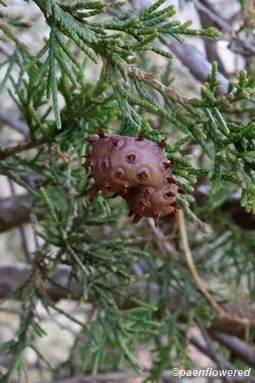
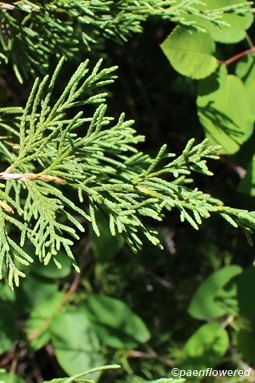
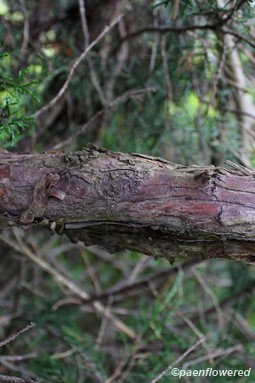
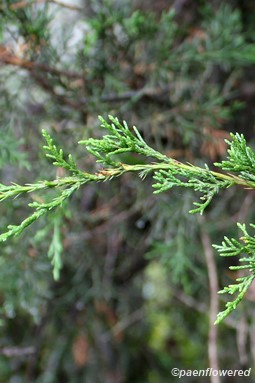
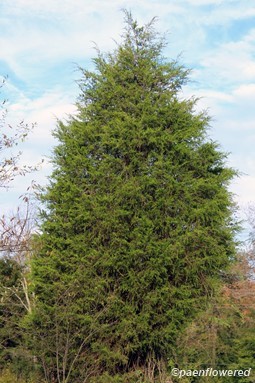


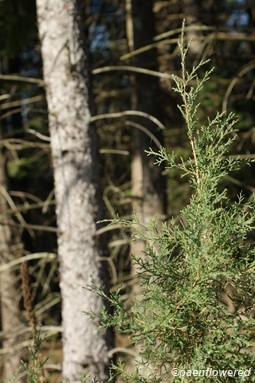

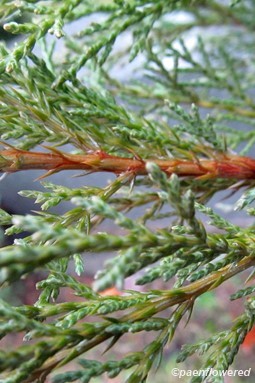


Comments
Have you spotted this plant in your area? We'd love to hear about your experience! Share your comments or questions about the plant below. Comments are moderated before posting.